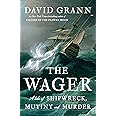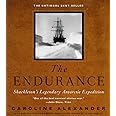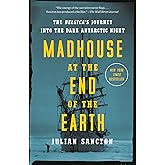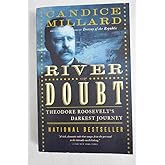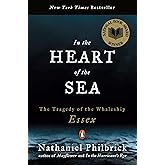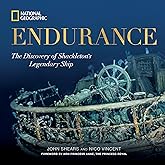
Amazon Prime Free Trial
FREE Delivery is available to Prime members. To join, select "Try Amazon Prime and start saving today with FREE Delivery" below the Add to Cart button and confirm your Prime free trial.
Amazon Prime members enjoy:- Cardmembers earn 5% Back at Amazon.com with a Prime Credit Card.
- Unlimited FREE Prime delivery
- Streaming of thousands of movies and TV shows with limited ads on Prime Video.
- A Kindle book to borrow for free each month - with no due dates
- Listen to over 2 million songs and hundreds of playlists
Important: Your credit card will NOT be charged when you start your free trial or if you cancel during the trial period. If you're happy with Amazon Prime, do nothing. At the end of the free trial, your membership will automatically upgrade to a monthly membership.
Buy new:
-32% $13.59$13.59
Ships from: Amazon.com Sold by: Amazon.com
Save with Used - Good
$9.98$9.98
Ships from: Amazon Sold by: Jenson Books Inc

Download the free Kindle app and start reading Kindle books instantly on your smartphone, tablet, or computer - no Kindle device required.
Read instantly on your browser with Kindle for Web.
Using your mobile phone camera - scan the code below and download the Kindle app.

-

-

-
 6 VIDEOS
6 VIDEOS -



 Audible sample
Audible sample Endurance: Shackleton's Incredible Voyage Paperback – Illustrated, April 28, 2015
Purchase options and add-ons
In August 1914, polar explorer Ernest Shackleton boarded the Endurance and set sail for Antarctica, where he planned to cross the last uncharted continent on foot. In January 1915, after battling its way through a thousand miles of pack ice and only a day's sail short of its destination, the Endurance became locked in an island of ice. Thus began the legendary ordeal of Shackleton and his crew of twenty-seven men. When their ship was finally crushed between two ice floes, they attempted a near-impossible journey over 850 miles of the South Atlantic's heaviest seas to the closest outpost of civilization.
In Endurance, the definitive account of Ernest Shackleton's fateful trip, Alfred Lansing brilliantly narrates the harrowing and miraculous voyage that has defined heroism for the modern age.
- Print length357 pages
- LanguageEnglish
- PublisherBasic Books
- Publication dateApril 28, 2015
- Dimensions5.45 x 1.3 x 8.25 inches
- ISBN-100465062881
- ISBN-13978-0465062881
The Amazon Book Review
Book recommendations, author interviews, editors' picks, and more. Read it now.
Frequently bought together
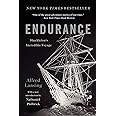
Similar items that may deliver to you quickly
 those that burdened themselves with equipment to meet every contingency had fared much worse than those that had sacrificed total preparedness for speed.Highlighted by 2,744 Kindle readers
those that burdened themselves with equipment to meet every contingency had fared much worse than those that had sacrificed total preparedness for speed.Highlighted by 2,744 Kindle readers Unlike the land, where courage and the simple will to endure can often see a man through, the struggle against the sea is an act of physical combat, and there is no escape. It is a battle against a tireless enemy in which man never actually wins; the most that he can hope for is not to be defeated.Highlighted by 2,443 Kindle readers
Unlike the land, where courage and the simple will to endure can often see a man through, the struggle against the sea is an act of physical combat, and there is no escape. It is a battle against a tireless enemy in which man never actually wins; the most that he can hope for is not to be defeated.Highlighted by 2,443 Kindle readers For scientific leadership give me Scott; for swift and efficient travel, Amundsen; but when you are in a hopeless situation, when there seems no way out, get down on your knees and pray for Shackleton.Highlighted by 2,230 Kindle readers
For scientific leadership give me Scott; for swift and efficient travel, Amundsen; but when you are in a hopeless situation, when there seems no way out, get down on your knees and pray for Shackleton.Highlighted by 2,230 Kindle readers In some ways they had come to know themselves better. In this lonely world of ice and emptiness, they had achieved at least a limited kind of contentment. They had been tested and found not wanting.Highlighted by 1,954 Kindle readers
In some ways they had come to know themselves better. In this lonely world of ice and emptiness, they had achieved at least a limited kind of contentment. They had been tested and found not wanting.Highlighted by 1,954 Kindle readers And yet they had adjusted with surprisingly little trouble to their new life, and most of them were quite sincerely happy. The adaptability of the human creature is such that they actually had to remind themselves on occasion of their desperate circumstances.Highlighted by 1,954 Kindle readers
And yet they had adjusted with surprisingly little trouble to their new life, and most of them were quite sincerely happy. The adaptability of the human creature is such that they actually had to remind themselves on occasion of their desperate circumstances.Highlighted by 1,954 Kindle readers
From the Publisher
|
|
|
|
|---|---|---|
|
|
|
|
Editorial Reviews
Review
"Riveting."―The New York Times
"Without a doubt this painstakingly written authentic adventure story will rank as one of the classic tales of the heroic age of exploration."―Christian Science Monitor
"Grit in the face of seemingly insurmountable adversity."―Wall Street Journal
"[An] incomparable telling of Shackleton's travails."―Mary Roach, New York Times Book Review
About the Author
Product details
- Publisher : Basic Books (April 28, 2015)
- Language : English
- Paperback : 357 pages
- ISBN-10 : 0465062881
- ISBN-13 : 978-0465062881
- Item Weight : 14.4 ounces
- Dimensions : 5.45 x 1.3 x 8.25 inches
- Best Sellers Rank: #1,083 in Books (See Top 100 in Books)
- Customer Reviews:
Videos
Videos for this product

1:08
Click to play video

Always in our collection! Here is why.
Heidi Leatherby

Videos for this product

0:41
Click to play video

Endurance
Amazon Videos
About the author

Alfred Lansing (July 21, 1921 – 1975) was an American journalist and writer, best known for his book Endurance (1959), an account of Ernest Shackleton's Antarctic explorations.
Bio from Wikipedia, the free encyclopedia.
Customer reviews
Customer Reviews, including Product Star Ratings help customers to learn more about the product and decide whether it is the right product for them.
To calculate the overall star rating and percentage breakdown by star, we don’t use a simple average. Instead, our system considers things like how recent a review is and if the reviewer bought the item on Amazon. It also analyzed reviews to verify trustworthiness.
Learn more how customers reviews work on AmazonCustomers say
Customers find the book amazing, fantastic, and well-done. They describe the story as riveting, thrilling, and suspenseful. Readers praise the writing quality as incredibly written, fantastic, and impeccably described. They also mention it's a great story of surviving against all odds. Customers find the story inspirational and one of the great achievements of mankind.
AI-generated from the text of customer reviews
Customers find the book entertaining, uplifting, and well-done. They also say it's relatable, endearing, and honest. Readers also mention the descriptions are vivid and chilling.
"...This book’s strongest point is the writing itself. The descriptions are vivid, and chilling as expected...." Read more
"...Great read!" Read more
"...It was such an incredible story that I truly enjoyed reading it. The story itself is amazing, and the author wrote it very well...." Read more
"Totally amazing book. Every one of my senses was in overload. A truly monumental endeavor. Thrilling to the last page." Read more
Customers find the story riveting, thrilling, and one of the finest nonfiction adventure novels. They also appreciate the prose as informative and suspenseful. Readers mention the book keeps their interest from start to finish.
"Adventure stories can often be captivating if the story is told the right way...." Read more
"...a museum exhibit about the expedition but this book brought the whole adventure to life. Great read!" Read more
"...Well, I couldn't put it down. It was such an incredible story that I truly enjoyed reading it...." Read more
"...A truly monumental endeavor. Thrilling to the last page." Read more
Customers find the writing quality detailed and descriptive. They also appreciate the fantastic narration. Readers mention the book is well-written, easy to read, and amazingly written. They mention the author impeccably describes the struggles, landscapes, weather, and men. What's more, they say the pages spring to life.
"...The book is written in great detail and I found myself turning the pages quickly, anxious to know what would happen next...." Read more
"...a couple members of the crew kept journals, so the details and perspectives are interesting. Read this book; you'll be glad you did!" Read more
"...Mr. Lansing prefers to remain invisible, and his writing comes so naturally, and the result is that I felt like I was one of the crew members when..." Read more
"...In reading this unbelievable narrative story you feel like you are part of the team fighting to live another day and showing incredible ingenuity to..." Read more
Customers find the story remarkable, humbling, and spectacular. They appreciate the strength, endurance, and bravery of the men. Readers also mention that the struggles are real and the recounting of their experiences is mind-bending.
"...It’s a fantastic read and a story you will never forget." Read more
"Absolutely riveting! The accomplishments of these men are unbelievable...." Read more
"...Great story of surviving against all odds. Couldn't put it down." Read more
"...CONCLUSION. This book is an excellent model to other historians, as a guide on how to write history books. Love this book!..." Read more
Customers find the story inspiring, encouraging, and a testament to mind over matter. They appreciate the indomitable spirit and will to survive. Readers also say the author does an excellent job with the subject matter and brings the story of survival home.
"...so many impossible situations with courage and tenacity, and such wisdom!..." Read more
"...Every one of my senses was in overload. A truly monumental endeavor. Thrilling to the last page." Read more
"...No one was lost. All return as heroes. The most incredible story of survival ever told with diaries, logs and pictures( many lost) to prove it...." Read more
"Truly an amazing story that left me inspired. Learning about the courage of these men was fascinating to read...." Read more
Customers find the book incredible, believable, and riveting. They say it's better than any fiction book they have read in a while. Readers also mention it's their favorite non-fiction book.
"...The author produced a great factual account but the story is so gripping that I had hoped for more tension . Still, a great read." Read more
"...It is also a rare historical, non-fiction book that is as exciting as any novel...." Read more
"...The story is absolutely ridiculous on every level and completely true...." Read more
"Probably one of the best non-fiction books I’ve read. I felt like I was there with the crew as they went through this ordeal...." Read more
Customers have mixed opinions about the pacing of the book. Some mention it's fast and interesting, while others say the first half is slow and drags on forever.
"These lids fit perfectly and work great. Them seem to be well made and durable." Read more
"...DISASTER #5. Sometimes walk through the deep slush on the ice floe was very slow, for example, after one five hour walk the party had advanced only..." Read more
"...It provides a real sense of the dangers and remoteness of the area, while getting a sense of the strength of character of the team on this adventure." Read more
"...It’s going by quickly as well." Read more
Customers have mixed opinions about the book. Some mention it's very readable and hard to put down, while others say it's hard to get into at first and tedious in the early going.
"...Well written and hard to put down. Highly recommended!" Read more
"Hard to get into at first, but found myself immersed...." Read more
"...Hard to put down and couldn't wait to get back to it. i would add more stars if i could." Read more
"...Great read and really hard to put down because even though you think you know what's going to happen, you still have to find out how...." Read more
Reviews with images
Ernest Shackleton's Fight to Survive
-
Top reviews
Top reviews from the United States
There was a problem filtering reviews right now. Please try again later.
For those not familiar with the journey, it all began on a relatively small, sea- going vessel. Ernest Shakleton was a man on a mission. He wanted to not just reach the South Pole- something that had already been done- but to traverse the entire Antarctic continent. He wanted to be the first person to accomplish such a feat, and he was bound and determined to make his goal a reality.
Things did not go as planned, and Shackleton and his team were forced to focus on the only thing that mattered: Survival. Their shop was wrecked beyond repair and he and his crew were forced to live on floating ice sheets, food rations, seal blubber for fuel, and anything else to keep them alive. Their only hope was to reach one of the nearby outposts of civilization. But would they all make it back alive? Or would the merciless Antarctic cold prove too difficult an obstacle to surmount?
I have heard about Ernest Shackleton and his voyage, but until I read this book, I didn’t know the specifics of how it turned out. The book is written in great detail and I found myself turning the pages quickly, anxious to know what would happen next. There were many points that would have caused some people to lose hope, but Shackleton was determined to get himself and his crew back to safety.
This book’s strongest point is the writing itself. The descriptions are vivid, and chilling as expected. You feel like you are right there with Shackleton and his team; feeling the cold wind, yearning for a good meal, hoping to get the feeling back in your limbs, and dreaming of a good night’s sleep. But more than anything, your hope is to survive. Nothing matters unless you can escape the frigid conditions and eventually make your way back to civilization.
One surprise with this book is that it includes a picture section. Like any good explorer, Shackleton made sure to have a team of photographers with him and the film managed to survive. There is one spoiler alert I should point out: If you want the suspense to continue, you may want to skip at least the last picture in this section, since it identifies the survivors.
The Antarctic continent is among the harshest, if not the harshest, climate on the planet. Ernest Shackleton’s voyage to this unforgiving land and his attempt to rescue his crew are brought to life in the pages of Endurance. It’s a fantastic read and a story you will never forget.
Reviewed in the United States on September 5, 2023
For those not familiar with the journey, it all began on a relatively small, sea- going vessel. Ernest Shakleton was a man on a mission. He wanted to not just reach the South Pole- something that had already been done- but to traverse the entire Antarctic continent. He wanted to be the first person to accomplish such a feat, and he was bound and determined to make his goal a reality.
Things did not go as planned, and Shackleton and his team were forced to focus on the only thing that mattered: Survival. Their shop was wrecked beyond repair and he and his crew were forced to live on floating ice sheets, food rations, seal blubber for fuel, and anything else to keep them alive. Their only hope was to reach one of the nearby outposts of civilization. But would they all make it back alive? Or would the merciless Antarctic cold prove too difficult an obstacle to surmount?
I have heard about Ernest Shackleton and his voyage, but until I read this book, I didn’t know the specifics of how it turned out. The book is written in great detail and I found myself turning the pages quickly, anxious to know what would happen next. There were many points that would have caused some people to lose hope, but Shackleton was determined to get himself and his crew back to safety.
This book’s strongest point is the writing itself. The descriptions are vivid, and chilling as expected. You feel like you are right there with Shackleton and his team; feeling the cold wind, yearning for a good meal, hoping to get the feeling back in your limbs, and dreaming of a good night’s sleep. But more than anything, your hope is to survive. Nothing matters unless you can escape the frigid conditions and eventually make your way back to civilization.
One surprise with this book is that it includes a picture section. Like any good explorer, Shackleton made sure to have a team of photographers with him and the film managed to survive. There is one spoiler alert I should point out: If you want the suspense to continue, you may want to skip at least the last picture in this section, since it identifies the survivors.
The Antarctic continent is among the harshest, if not the harshest, climate on the planet. Ernest Shackleton’s voyage to this unforgiving land and his attempt to rescue his crew are brought to life in the pages of Endurance. It’s a fantastic read and a story you will never forget.

Reviewed in the United States on December 27, 2023

The book begins on August 1, 1914, when the Endurance set sail from London. The story ends on August 30, 1916, when Shackleton managed to land his rescue ship on Elephant Island, Antarctica, to retrieve the men who were left behind. The expedition was called, IMPERIAL TRANS-ANTARCTIC EXPEDITION, and all 28 men are listed on page 1 of the book. The book has two maps, the first tracking the location where Endurance was trapped (Jan. 19, 1915) in ice, the location where Endurance was crushed and therefore abandoned (Oct. 27, 1915), the location of the men's journey on the moving ice floe, and the final 100 mile stretch where the men took three small boats to Elephant Island to land on April 9, 1916. The second map shows the entire journey of Endurance from South Georgia Island to just off the coast of Antarctica, and the journey of one of the three small boats (the Caird) from Elephant Island back to South Georgia Island, where Shackleton successfully rounded up a rescue party.
There are six black and white photos, taken by crew member Frank Hurley. The photos show the Endurance locked in ice, the Endurance after being crushed, Frank Hurley posing with Ernest Shackleton by their tent on an ice floe (taken on May 10, 1916), and a photo of the rescue vessel arriving on August 30, 1916. There are also reproductions of two paintings by the ship's artist.
THE WRITING. Aside from a handful of literary excesses in the first several pages, this book is absolutely devoid of journalistic fluff. There is no attempt at re-creating conversations. There is no attempt at drama or pathos. There is no attempt to impress the reader with difficult words or with long sentences. I love Mr. Lansing's writing style. Mr. Lansing prefers to remain invisible, and his writing comes so naturally, and the result is that I felt like I was one of the crew members when I read the book.
CLIFF HANGERS. The narrative provides a dozen or so cliff hangers, where the reader is aware that the men are faced with the threat of immediate death. These threats include savage storms at sea, having an ice floe disintegrate under the men's camping area, threats of having the three small boats crushed between ice floes, and threats of freezing to death. In the final chapter, when Mr. Shackleton set foot on South Georgia Island, and attempted to cross the Island on foot, he repeatedly took pathways that led to a dead-end that terminated at the top of a high cliff, producing the threat of death due to lack of food and exposure to the cold.
OPTIMISM AND COURAGE. In a broader sense, the book is an illustration of courage in the face of constant life-threatening cold, and in the face of the threat of being lost at sea. The book provides little explicit guidance on the meaning of leadership, but it is easy to read between the lines. We learn that Mr. Shackleton never expressed thoughts of hopelessness, the fact that none of the men were drama queens (see, page 40), the fact that the men possessed a good sense of humor (see page 42), were incapable of malice (page 78), and were willing to join in singing (pages 17, 45, 75). What also helped keep the men in good spirits was that one man had a banjo, and that there was ususually plenty of powdered milk, canned beets and cauliflowers, and biscuits on hand. My own personnal opinion is as follows. Although it is difficult to eliminate drama queens during the job interview process, it is very easy to keep employees in good spirits by providing free food at regular intervals.
EXCERPTS. We learn that the trip was funded by James Caird ($120,000), the UK government ($50,000), and the Royal Geographic Society ($5,000). We learn that second in command was Frank Wild, who had accompanied Shackleton on earlier trips to Antarctica. We learn that Endurance set sail from London the week that World War I started. The Endurance had three sails and a coal-fired 350 hp steam engine, that she was designed by Aanderud Larsen, and was built in Norway. Frank Hurley, the photographer, had already been to Antarctica with another explorer (Douglas Mawson). Sixtynine dogs were also brought along, though they never had a chance to pull the sledges over Antarctica.
DISTASTER #1. On page 30, Endurance gets permanently trapped in ice. Although this entrapment occurred only 60 miles away from land, the ship was trapped in an ice floe that has a surface that was too "hummocky" to risk travel (page 34).
DISASTER #2. By page 36, a quarter of the dogs had died, and the cause was foot long red worms.
DISASTER #3. We learn that the ship's order of phonograph needles was discovered, instead, to consist of a box of 5,000 sewing needles (page 43). This is not really a disaster, but it is amusing to recount this.
DISASTER #4. On page 59, the ship, which had been trapped for nine months, was finally crushed, and the men rescued their mittens, tobacco, surgical instruments, banjo, photographic negatives, cases of sugar, flour, rice, barley, and jam, stoves, and toothbrushes (page 80).
DISASTER #5. Sometimes walk through the deep slush on the ice floe was very slow, for example, after one five hour walk the party had advanced only a half mile (page 93). At one point, a sea leopard attacked Thomas Orde-Lees, and he was rescued by Frank Wild, who shot the sea leopard, which weighed 1,100 pounds (page 102).
DISASTER #6. The banjo-playing proved to be torture, because Leonard Hussey (meteorologist) knew only six tunes (page 104). It is amusing to recount this, even though it is not really a disaster.
DISASTER #7. The men complained that their meat-based diet (seals, sea leopards, penguins, dog pemmican) was causing flatulence and a "squeaky gut." Ice was used for toilet paper, and ice freezing on the skin caused chronically unhealed sores (page 112).
DISASTER #8. The continued drift of the ice floe brought the men too far north to be able to debark at Paulet Island, leaving open the possibility of debarking at islands further to the north, such as Elephant Island or drifting even further north to be lost at sea in the dreaded DRAKE PASSAGE (pages 117-121, 124, 134).
DISASTER #9. Food shortages with concomitant sub-zero temperatures was an occasional threat (page 122). The continued failure of the ice pack to disintegrate prevented the men from sailing to land, which at one point, was only 42 miles away (page 123). The ice was too lumpy to cross, and the floes were too close to each other for a safe sailing.
DISASTER #10. Eventually, the ice floes used by the men for camping started to break apart (pages 128, 132, 137) and on page 138, the three small boats were launched. Killer whales surfaced on all sides of the boats (page 141), and masses of churning ice caused by rip tides threatened to overturn the boats (page 141). It is interesting to point out that the small boats were caulked with seal blood, or with cotton lamp wick and oil paints (pages 85, 107).
CONCLUSION. This book is an excellent model to other historians, as a guide on how to write history books. Love this book! The last time I read a book like this was in elementary school, when I read THE RAFT by ROBERT TRUMBULL. The Raft is another non-fiction book about survival at sea. I read The Raft during the time of the Seattle World's Fair (ha, ha, not really recently).
Top reviews from other countries
If, sometimes,you wonder if your manager is good or no, read this book and compare him to Shackleton.













